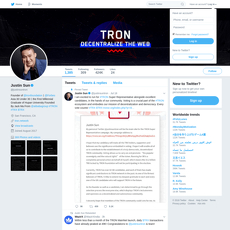Chamath Palihapitiya Review
Chamath Palihapitiya
x.com
Chamath Palihapitiya (@chamath) on X: Review Guide — Everything You Need to Know with FAQ
Are you actually getting smarter—or just more distracted—by following @chamath on X? If crypto and markets matter to you, the difference between signal and noise can make or break your decisions.
The problem: Crypto Twitter is noisy and confusing
Scroll long enough and everything starts to sound urgent. One thread says “risk-on,” the next warns “recession incoming.” Chamath Palihapitiya is influential, opinionated, and plugged into tech and public markets. He’s had sharp calls and public misses. If you don’t have a simple framework, you’ll end up reacting to the loudest take instead of the most useful one.
Here’s the catch: social feeds reward engagement, not accuracy. Studies have shown that investor sentiment on platforms like X can swing short-term behavior—even when the underlying info isn’t predictive of outcomes. For example:
- Bollen, Mao, Zeng (2011) found that aggregate Twitter mood could predict certain stock market moves—highlighting how social sentiment affects decision-making.
- Sprenger et al. (2014) showed “stock microblogs” carry tradable information—but also a lot of noise that tempts overtrading.
That’s why you need a way to follow big voices like Chamath without getting whipsawed by every post.
Pro tip: Treat influential feeds as inputs to your model—not your model.
On a typical week, you might see him post:
- Macro context around rates, inflation, or liquidity—often tied to policy decisions or data prints.
- Tech/AI outlook and how it spills over into public markets and startups.
- Clips from the All-In Podcast that frame big themes (policy, elections, regulation).
All of that can be useful—if you know what to save and what to skip.
What I promise in this guide
I’ll keep this practical and cut the fluff. You’ll get:
- What you actually get by following @chamath (and what you don’t).
- Where the signal shines—posts that help you think in frameworks, not hot takes.
- Where bias creeps in—so you don’t mistake promotion for insight.
- Crypto-specific value—how his macro lens maps to Bitcoin and broader adoption.
- Fast FAQ—clear answers to the questions people ask the most.
What you’ll walk away with and who this is for
By the end, you’ll know his content pillars, how he posts, and a quick system to get value without camping on the timeline.
- Traders: Grab macro context to sharpen your risk calendar without chasing every headline.
- Founders: Understand how capital allocators think about cycles, rates, and product-market fit narratives.
- Curious investors: Get a clean view of where his posts help—and where you should hit mute.
Here’s the question that sets up everything else: who exactly is Chamath, and why do crypto folks keep tabs on him? The next section answers that—and might change how you read his feed forever. Ready to look under the hood?
Who is Chamath, and why should crypto folks care?
If you trade crypto, build products, or simply watch liquidity like a hawk, you want to understand the people who shape the conversation. Chamath Palihapitiya isn’t just loud on X—he’s a capital allocator with a public record, a massive audience, and a knack for framing cycles in a way that sticks. When he posts, funds, founders, and the mainstream pay attention. That attention can sway sentiment—and sometimes, price.
“Bitcoin is schmuck insurance.” — Chamath Palihapitiya
I don’t follow quotes; I follow behavior. His shows, threads, and interviews consistently return to the same themes: rates, risk, regulation, and product-market reality. That’s where crypto lives.
Quick bio snapshot
He’s had a rare mix of operating, investing, and media reach that makes his feed uniquely useful:
- Operator: Early Facebook exec (VP of Growth). Knows how distribution really works—the oxygen every crypto project needs.
- Investor: Founder of Social Capital, backing tech, health, fintech, and occasionally frontier plays that rhyme with crypto’s long game: networks, data, and incentives.
- Public-markets player: High-profile SPAC sponsor (e.g., Virgin Galactic), comfortable straddling private and public markets—useful context for crypto’s increasing institutionalization.
- Media voice: Co-host of the All-In Podcast, where macro and tech collide in front of a very large audience.
That mix—operator discipline, venture lens, public-market exposure, and media reach—makes his take on crypto feel less like a hot take and more like a playbook checkpoint.
Social Capital and the All-In effect
When he posts, it’s often tied to how capital allocators actually think: rates, liquidity, time horizons, and where real adoption starts. That’s gold for crypto, where narratives run faster than fundamentals.
- Firm lens: He shares portfolio-style thinking—what happens to risk assets if the cost of capital moves 100 bps, or if regulatory pressure tightens. I treat these as stress-test prompts for my own crypto thesis.
- Amplifier: All-In clips and threads frequently hit millions of impressions on X and YouTube. That matters. Peer-reviewed research has shown social-media sentiment can predict short-term crypto returns and volatility (Kraaijeveld & De Smedt, 2020; Mai et al., 2018).
- Timing spikes: Around rate decisions, bank stress, ETF headlines, or big tech earnings, his posting cadence jumps—exactly when crypto correlations with macro tend to tighten.
In other words: his feed isn’t just commentary—it’s a signal of what high-level money is thinking right now.
Crypto relevance
He’s been early to Bitcoin and consistently frames it through macro, not memes:
- Bitcoin as macro asset: He’s framed BTC as hedge/option value against policy errors and debasement—useful when you model it alongside real rates and liquidity.
- Altcoin caution: He rarely chases alt narratives. When he talks non-BTC, it’s tied to utility, distribution, and the regulatory lane—good guardrails if you’re filtering noise.
- Policy lens: Expect takes on the US vs. the rest of the world, innovation competitiveness, and election-season risk. I keep a note: if his policy angle lines up with my liquidity dashboard, I re-check exposure.
I find the value isn’t in “buy/sell” but in the frameworks: how he ties rates, regulation, and adoption to risk windows that crypto actually trades on.
Influence and reach
Millions see his posts. That changes how quickly narratives spread. A simple example: when he frames a rate path shift or calls out regulatory posture, I watch for:
- Sentiment jolts: X sentiment tilts can lead to fast positioning changes—especially in BTC and high-beta alts.
- Media echo: Clips ricochet to CNBC, YouTube, and podcasts, reinforcing the narrative loop that moves retail and even some funds.
- Founder behavior: Builders tweak messaging to fit the moment (compliance-first, product-first, infra-first), which affects what gets funded and what gets attention on-chain.
He’s not a market wizard. He is, however, a powerful framing device. And in crypto, the frame often sets the next trade.
Want to know exactly what you’ll see when you follow @chamath—and how to separate signal from noise? Let’s look into his posting patterns, content pillars, and what’s actually actionable next.
What you actually get from following @chamath on X
If you’re looking for quick “buy this now” posts, you’ll be disappointed. If you want clear context around rates, liquidity, tech cycles, and how big money thinks—this is where his feed shines. Expect macro takes, tech/investing threads, links to long-form talks, and short All-In clips that tee up bigger debates. The value is context, not signals.
“In markets, context beats calls. The right lens saves you from the wrong trade.”
Content pillars you’ll see often
- Macro and rates: Posts and clips that connect inflation, the Fed’s path, deficits, and real yields to risk assets. This is where crypto traders can calibrate their risk—macro surprises still move Bitcoin and majors, and central bank research has repeatedly shown crypto’s sensitivity to U.S. monetary news.
- Tech and AI outlook: Notes on compute bottlenecks (GPUs, foundries), platform shifts, and distribution. Useful for mapping where capital is flowing, which often spills into crypto infrastructure narratives.
- Public markets and sectors: Opinions on megacap earnings, multiples, and profitability. Helps frame risk-on/risk-off regimes that crypto tends to echo.
- Policy and regulation: Takes on elections, antitrust, and U.S. competitiveness. Good for gauging mood and tail-risk scenarios that can reprice crypto overnight.
- Startup/investing lessons: Threads on unit economics, incentives, and compounding. I save these because they’re timeless and portable to crypto teams and token design.
- All-In Podcast promos and live threads: Short clips that summarize a bigger argument. Think of these as previews—if the clip hits your watchlist (rates, liquidity, crypto regulation), jump into the full episode for the “why.”
Example of practical value: when he frames “higher-for-longer” in the context of real yields and risk premia, that’s a nudge to check your exposure to long-duration bets—altcoins included. Multiple studies from central banks and academia point to crypto’s tight linkage with dollar liquidity, equity beta, and real rates during stress periods; I treat his macro posts as prompts to refresh those dashboards rather than as trades.
Posting patterns and tone
He’s opinionated and confident, but typically brings receipts—links to articles, charts, or a segment from a longer conversation. You’ll notice bursts of activity during major CPI/FOMC weeks, around All-In episode drops, and when policy news breaks. Expect succinct one-liners on news days and longer “here’s the math” threads when he’s laying out a framework. The tone is assertive, occasionally contrarian, and sometimes promotional when it intersects with his platforms—so I separate the marketing from the model.
- Cadence: A handful of posts most weeks; spikes during macro events and show releases.
- Format mix: Quote-tweets with commentary, threads that build a narrative, and clips that compress the argument into 60–120 seconds.
- Data cues: References to yields, deficits, tech adoption curves, and business model mechanics. If there’s a chart, I read it; if it’s a dunk, I move on.
Signal vs. noise: what’s actually actionable
- Save these (high signal):
- Framework threads that tie together rates → liquidity → risk premia. These help you build rules for when to add/reduce crypto beta.
- Risk factor checklists (e.g., real yields, DXY, Treasury issuance, term premium) that you can mirror in your own dashboard.
- Policy maps that outline potential regulatory paths and second-order effects.
- Skim or skip (low signal):
- One-liners without data.
- Victory laps or pile-ons.
- Political spats that don’t change your thesis or risk metrics.
Why this filter works: across cycles, Bitcoin and large caps have responded most consistently to liquidity and rates. That’s not an opinion—it’s backed by a growing body of research and by lived PnL. So when a post gives you a testable mechanism (e.g., “rising real yields compress risk assets”), it’s worth archiving. When it’s narrative without numbers, it’s entertainment.
How I follow for maximum value
- Use Lists to cut noise: Create a private X List called Macro + VC and add @chamath along with a few macro/market analysts you trust. Lists isolate the posts you care about, away from your main feed’s chaos.
- Set smart alerts: Turn on notifications for him, but only check when your watchwords appear: “rates,” “real yields,” “liquidity,” “Bitcoin,” “regulation.” A quick control-F on his profile or an X Pro (TweetDeck) column with those keywords keeps it efficient.
- Bookmark frameworks, not reactions: When he posts a thread with a model or checklist, save it. I tag mine by theme—Rates, Liquidity, Policy—so I can revisit before major prints or rebalancing.
- Cross-check in 2 minutes: Pair any macro post with a fast dashboard pass: real yields (TIPs), DXY, S&P futures, Treasury issuance calendar, and crypto majors’ OI funding. If his point aligns with the tape and your data, you’ve got a useful input.
- Mute for focus: If you want markets-only, mute heated political terms. It keeps the feed actionable and your head clear.
- Read the Quotes: Click “Quotes” on any viral post. You’ll often find informed pushback or extra data that either strengthens the framework or exposes the holes.
- Mind the timeframe: He often speaks in quarters and years. If you’re trading hours and days, translate the idea into your timeframe before you act.
Bottom line for this section: follow for mental models you can test, not for trade calls you can copy. But here’s the real question you probably care about—when he talks crypto specifically, what themes actually matter, and how do I decide if a post is a nudge to adjust my Bitcoin or alt exposure? Let’s look at that next…
Chamath on crypto: themes, takes, and how to use them
When I read Chamath on crypto, I don’t look for tickers—I look for the three switches he always watches: liquidity, policy, and distribution. That’s his edge. He treats Bitcoin like a macro asset, altcoins like products that live or die on real adoption, and the whole space as a function of rule-making and pipes that move money.
“Bitcoin is schmuck insurance.” — Chamath Palihapitiya
That line stuck with me not because it’s catchy, but because it reveals his frame: protect yourself from tail risks while riding the cycles created by central banks and politicians. If you use his posts as a dashboard instead of a signal, you’ll get compounding value.
Bitcoin stance across cycles
He’s consistently framed Bitcoin as a macro hedge and liquidity beneficiary, not a meme. The useful bit isn’t “number go up”—it’s the why behind it:
- Rates and real yields: When real yields fall, risk assets with long-duration narratives tend to catch a bid. BTC has often moved inversely to the 10-year real yield. You can check the real yield series on FRED and overlay BTC on any price chart; the 2020–2021 run (yields down) and 2022 drawdown (yields up) mirror that relationship.
- Liquidity proxies: He’ll connect BTC performance to dollar strength (DXY), central bank balance sheets, and stablecoin net issuance. A stronger dollar and QT headwind crypto; easing and balance sheet growth help. For a quick read, track the broad dollar index on FRED and compare with BTC.
- Institutional flows: He sees vehicles like spot ETFs as distribution breakthroughs. Since approval, flow trackers show sustained net inflows, a structural tailwind for BTC as an “owned by pros” asset. I monitor Farside’s ETF flow dashboard for a reality check.
Is this just narrative? Not entirely. Multiple sell-side and research notes since 2020 have shown negative correlations between BTC and real yields, and improving returns when global liquidity expands. It’s not perfect, but it’s a cleaner compass than hype.
Altcoins and infrastructure
Here’s where he gets choosy. He rarely cheers altcoins by ticker. When he does talk about the long tail, it’s in product terms:
- Clear use case > cute tokenomics: Payments, settlement, remittances, and dollar access beat casino coins. Stablecoins are the best example—on-chain settlement has hit trillions per year, rivaling card networks. For context, see Coin Metrics’ ongoing State of the Network reports on stablecoin transfer volumes.
- Distribution and UX: He respects pipes. Custody, compliance, and easy onramps matter more than TPS marketing. Think ETFs, PayPal/Fintech rails, regulated brokers adding crypto, and mobile wallets with fiat ramps.
- Network effects: He favors platforms where developer activity, liquidity depth, and integrations stack over time. If there’s no flywheel (users → apps → liquidity → users), he’s skeptical.
So when he’s positive on “infrastructure,” I translate it as: better custody, faster/cheaper settlement that normal people can touch, and compliance that lets institutions show up.
Regulation and policy
Expect strong takes on U.S. competitiveness and whether policy invites or scares off builders. That’s not just punditry; it’s a flow map:
- U.S. vs. everyone: The EU’s MiCA gives clarity; Hong Kong and the Middle East are trying to attract capital; U.S. headlines swing between enforcement and slow-walked rules. He reads these as distribution gates or walls.
- Election seasons: He’ll assign probabilities to policy pivots around elections. Treat those as scenario prompts. Ask: if stablecoin legislation passes, which tickers actually benefit? If ETF approvals expand, where does the money route first?
- Watch the base money rails: Stablecoin supply growth has been a sneaky liquidity proxy. Rising net issuance tends to line up with stronger crypto risk appetite; flat or shrinking supply often coincides with risk-off. You can cross-check this on Glassnode or Coin Metrics.
When he flags a policy window opening or closing, I don’t trade the tweet. I map the affected pipes: which exchanges, wallets, custodians, and assets stand to gain or lose access to mainstream capital?
How I use his posts
I treat Chamath like a macro “check engine” light for crypto. Here’s my simple workflow:
- If he’s talking rates/real yields: I refresh my dashboard: 10-year real yield, DXY, and BTC’s correlation. If real yields are rolling over and ETF inflows are strong, I consider adding beta. If real yields are spiking, I trim leverage and reduce alt exposure first.
- If he’s on regulation/policy: I run a scenario tree. Example: a credible U.S. stablecoin bill → positive for payment-focused rails and compliant issuers; uncertain DeFi tokens still carry headline risk. No knee-jerk; just position sizing.
- If he’s pushing “infrastructure”: I check adoption metrics, not narratives: stablecoin transfer volumes, active addresses, developer traction, and fee trends. If UX and distribution are improving, I’m more comfortable holding through noise.
- Always: I save threads that contain actual frameworks or data and ignore pile-ons and victory laps.
Two numbers I watch because his posts often point there without saying it: net stablecoin issuance and ETF net flows. Those two alone can explain a surprising amount of crypto’s mood.
Red flags and bias to remember
He’s human, and platform incentives are real. I keep this checklist handy so I don’t get spun by a hot take:
- Platform promotion vs. thesis: If the post coincides with a show clip or headline moment, I ask: where’s the data?
- Time horizon mismatch: He thinks in quarters and years; Crypto Twitter trades in hours. Don’t confuse the two.
- Selection bias: Big wins get airtime, messy middles don’t. I backtest claims against neutral sources (FRED, ETF flow trackers, on-chain analytics).
- Overgeneralization risk: “Crypto” is not one asset. I separate Bitcoin (macro/flows) from altcoins (product/PMF) before acting.
At the end of the day, I use his feed to feel the macro temperature without letting it set my thermostat. When he’s right, you’ll feel that rush. When he’s early or off, you’ll feel the whiplash. The real trick is knowing which is which in real time.
So here’s the question I always get: how often has that macro compass actually paid off—and where did it steer people wrong? Keep going; I’m laying out the wins, the misses, and what you can safely copy next.
Track record: wins, misses, and what that means for you
Here’s the honest lens I use: strong track records are messy up close. You want pattern recognition, not idol worship. Big calls, big whiffs—what matters is how you turn that into better filters for your own crypto and market decisions.
“Wins whisper, losses shout. Listen to both.”
Major wins he’s known for
There’s real signal in the early trend-spotting—and the courage to size up when it counts.
- Early Bitcoin conviction — Years before institutions showed up, he was framing BTC as “schmuck insurance.” That framing—hedge against policy error and liquidity shocks—aged well as a mental model, even through brutal drawdowns. See: CNBC coverage of his BTC thesis.
- Slack — Social Capital was an early backer. Slack’s 2019 direct listing turned into a standout return and a case study in product-market fit compounding. Useful lesson: prioritize category creation and distribution wins. Related read: Who won Slack’s direct listing.
- Virgin Galactic (SPCE) — Took SPCE public via SPAC in 2019 (IPOA). Early holders saw explosive upside into 2021 as space + retail enthusiasm collided. It later round-tripped (see “misses”), but the initial trade speaks to timing narrative + liquidity. Chart context: SPCE price history.
- Amazon and Tesla — Publicly bullish when many were skeptical. The core insight wasn’t just “own the winners,” it was recognizing how platform economics and cost curves (software, EV batteries) rewrite cash flow trajectories. Example: his 2020 case for Tesla’s multi-trillion path.
Pattern to keep: back products with network effects, secular tailwinds, and a credible path to institutional adoption. That lens translates directly to crypto infra and BTC/ETH cycles.
Notable misses and controversies
If you only read victory laps, you’ll miss the tuition. A few realities worth logging:
- SPAC fallout — Post-2021, many SPACs cratered, including names he sponsored or championed (e.g., Opendoor, Clover Health, and the later phases of SPCE). Retail holders who chased peaks took heavy hits. This isn’t unique to him—studies found structural issues in SPAC value capture. Stanford/NYU’s “A Sober Look at SPACs” shows median post-merger value well below $10 per share; dilution and redemptions hurt outcomes. Source: Klausner, Ohlrogge, Ruan (SSRN).
- Timing on macro narratives — Strong takes on rates, liquidity, and policy sometimes met reality on a different clock. Aggressive targets (think “sooner-than-later” pivots or six-figure BTC timelines echoed widely across 2020–2021) didn’t materialize when many expected. The lesson isn’t “ignore macro,” it’s timeframe humility.
- Public-platform risk — He plays in the arena. Loud calls invite scrutiny and occasional walk-backs; political flashpoints (separate from investing) can distract from the finance signal. For your PnL, that’s a reminder to separate message from model.
Pattern to keep: stories can front-run fundamentals for months—sometimes years. When the story fades, only unit economics and real demand remain. If you’re late to a story stock (or token), you’re trading sentiment, not value.
Related context for traders: academic work on attention-driven flows finds that retail-chased spikes underperform, on average. See Barber, Huang, and Odean’s “Attention Induced Trading and Returns” for the mechanism behind 2020–2021 frenzies: SSRN paper.
Investment style and risk appetite
Understanding the style helps you decide what to emulate—and what to quarantine.
- Thematic, concentrated bets — Picks multi-year shifts (AI, crypto, platform businesses) and isn’t shy about size.
- Comfortable being early — Will endure narrative whiplash if the thesis is intact.
- Uses public vehicles and public narratives — SPACs, podcasts, and X amplify the trade. That’s part edge, part hazard.
- Frameworks > tickers — At his best, he’s talking liquidity, cost curves, and distribution—portable to crypto cycles.
Pattern to keep: conviction is a skill and a liability. Borrow the former; manage the latter with your own risk rules.
What this means for your follow strategy
I treat his feed like a macro-and-tech overlay, not a signal generator. Here’s the playbook that actually helps my returns:
- Copy frameworks, not trades — Write down the thesis in one sentence (liquidity, rates, policy, utility). If you can’t, you don’t have a trade—just a vibe.
- Run a 6-question filter:
- What’s the time horizon implied?
- What data supports it? Link or it didn’t happen.
- Who benefits if this narrative spreads?
- What breaks the thesis? Name the kill-switch.
- Does this change my base case or just my emotions?
- How would I size this if I were wrong tomorrow?
- Cross-check with independent data — Rates and liquidity drive crypto beta. Quick anchors I use:
- Effective Fed Funds Rate (FRED)
- M2 money supply (FRED)
- CME FedWatch probabilities
- Beware attention traps — If a take is going viral, assume the entry is worse. Scale in only if the data—not the dopamine—still checks out.
- Journal the hit rate — Once a month, score how his frameworks matched the tape (BTC, ETH, liquidity, risk). Over 90 days, you’ll see what to keep and what to mute.
If you’re asking, “Okay, but where does he sit politically now, what’s he actually worth, and how do I set up X to catch only the useful stuff?”—you’ll like what’s next. Want the fast, no-BS answers in under two minutes?
FAQ: fast answers to what everyone asks about Chamath
Here’s the stuff I get asked the most about @chamath. It’s quick, practical, and I’ve added context so you don’t misread a headline or a one-liner on X.
Is Chamath Palihapitiya a Democrat or Republican?
He’s not neatly boxed in. Historically, he donated to Democrats, but by the early 2020s he voiced more support for Republican candidates and policies. He’s also backed specific figures across cycles, including a 2011 donation to Ted Cruz, which surprises people who only know his Bay Area tech roots.
If you’re trying to forecast his policy takes, think issue-by-issue rather than party-by-party: competition, innovation, regulation, and capital formation. That lens explains his shifts better than partisan labels.
Why you should care as a crypto person: policy and rates shape liquidity—and liquidity shapes crypto returns. Peer-reviewed research in journals like Finance Research Letters has linked Twitter attention/sentiment to short-term crypto volatility, so influential voices nudging the policy conversation can matter to your PnL.
What are Chamath’s most famous investments?
Headline wins people cite:
- Bitcoin: early position, publicly supportive across cycles.
- Slack: one of his best VC returns (roughly 10x is often quoted).
- Virgin Galactic (SPCE) via SPAC: splashy, controversial, widely followed.
- Amazon and Tesla: talked about taking big public-market swings.
Read these as a pattern: comfort with thematic bets, willingness to be early, and using public markets when it suits the thesis. That’s useful if you’re building your own “theme first” watchlist for crypto and AI.
How much is Chamath worth from the All-In Podcast?
All-In boosts reach and deal flow, but his wealth is from investing and Social Capital. Public estimates have ranged from roughly $1B to $4B+ depending on markets and private marks; in 2023, some outlets pegged him north of $4B. Treat any net worth number as a snapshot—these swing with tech multiples and liquidity conditions.
Tip: don’t anchor on a headline figure. What matters for you is how his frameworks reflect the current rate regime and risk appetite.
What does Chamath’s wife do?
He’s married to Nathalie Dompé (since 2023). She’s an Italian businesswoman and CEO of Dompé Holdings, with a background that includes work with brands like Vogue and Giorgio Armani. You’ll occasionally see her mentioned in lifestyle profiles, but she’s primarily focused on the Dompé family’s business empire.
How to get the most from his feed in 2 minutes
- Turn on thread notifications: his highest-signal content is usually multi-post frameworks with charts or links.
- Add to a curated List: put him in “Macro + Crypto + VC” alongside a rates strategist and one on-chain analyst. This keeps you out of the main feed doomscroll.
- Mute keywords if needed: try “election,” “left/right,” and specific politician names if you only want market content.
- Save the receipts: bookmark posts that include data, rate path views, or liquidity discussion. Revisit when markets swing.
- Set quick alerts: “Bitcoin,” “liquidity,” “rates,” “ETF,” “policy,” “regulation.” These terms tend to precede useful macro-context threads.
Pro move: when he mentions rates or liquidity, check it against a real-time dashboard (DXY, US 2Y/10Y, M2 trend, Bitcoin ETF flows). This is where his context turns into your edge.
Extra reading and resources
- Wikipedia: Chamath Palihapitiya
- All-In Podcast (site) and YouTube
- Social Capital and Perspectives
Want to know if you should actually follow @chamath given your risk style and time budget? I’ll answer that next—and share the exact rules I use to separate signal from noise before a trade. Ready?
Should you follow @chamath? My take
Short answer: yes—if you want big-picture context on macro and tech that helps you position for crypto cycles. Just don’t treat his posts like trade alerts. The value is in how he frames risk, rates, and adoption, not in catching tops and bottoms.
Best reasons to follow
- Macro context that maps to crypto cycles. When he hammers the cost of capital, liquidity, and policy risk, that’s directly relevant to Bitcoin and alt performance. In 2022–2023 he consistently emphasized higher rates and tighter liquidity; if you paired that with DXY strength and shrinking stablecoin supply, the picture for risk assets was clear. In early 2024, as spot Bitcoin ETFs launched and U.S. liquidity improved at the margin, that alignment helped explain why BTC reclaimed momentum as ETFs amassed tens of billions in AUM within months.
- Clean frameworks you can reuse. He’s strongest when he reduces complexity to a few levers: liquidity, regulation, product-market fit, distribution. I’ve saved threads where he connects rates to equity duration and risk appetite—useful for sizing crypto beta and avoiding overexposure when the cost of capital is rising.
- Policy and sentiment read-through. He’s early to frame how U.S. politics, regulation, and institutional behavior might shift. That’s valuable for front-running narrative turns (e.g., ETF legitimacy, stablecoin bills, or election-season positioning).
- Access to longer-form reasoning. The All-In clips and memos he posts are handy when you want to hear the full argument behind a stance. Even when I disagree, the structure helps stress-test my own model.
When to be cautious
- Promotional gravity. He will promote his platforms and positions. Remember the SPAC era: a lot of de-SPAC names eventually fell 60–90% from 2021 highs. Treat promotional content as marketing, not a mandate.
- Political hot takes. They move engagement, not your PnL. If you’re here for markets, filter those out.
- Victory laps, dunks, and one-liners. High entertainment, low signal. The durable value lives in threads that lay out assumptions and data.
- Timing trap. A correct macro narrative can still be early (or late). Pair his views with your own dashboard: DXY trend, 10Y yield, global liquidity proxies, stablecoin supply growth, BTC open interest/funding, and realized cap signals. If those disagree, don’t force trades.
Why this approach works: research shows attention and sentiment can move markets, especially in crypto. A few classics worth keeping in mind:
- Bollen, Mao, Zeng (2011) found Twitter mood links to market moves, a reminder that influential feeds shape behavior.
- Da, Engelberg, Gao (2011) showed attention (think search interest) impacts prices—useful context when big accounts steer the conversation.
- Kristoufek (2013) tied Bitcoin price/volume with Google Trends and Wikipedia views, underscoring how attention and liquidity interact in crypto.
My rule: use voices like his as inputs—not instructions. If his thesis rhymes with your data, lean in. If it clashes, wait.
Conclusion
Follow @chamath for frameworks and macro context, not trade timing. Save his best threads, mute the noise, and cross-check with your own indicators. If you want more practical, no-hype tools and setups I actually use, I publish them here: cryptolinks.com.
Quick setup I recommend:
- Add him to a “Macro + Crypto” List so you see arguments, not the entire firehose.
- Mute politics keywords if markets are your priority.
- Bookmark posts with data, charts, or clear assumptions; ignore the victory laps.
Do that, and his feed becomes an edge—calm, structured, and useful when it matters.
CryptoLinks.com does not endorse, promote, or associate with Twitter accounts that offer or imply unrealistic returns through potentially unethical practices. Our mission remains to guide the community toward safe, informed, and ethical participation in the cryptocurrency space. We urge our readers and the wider crypto community to remain vigilant, to conduct thorough research, and to always consider the broader implications of their investment choices.













